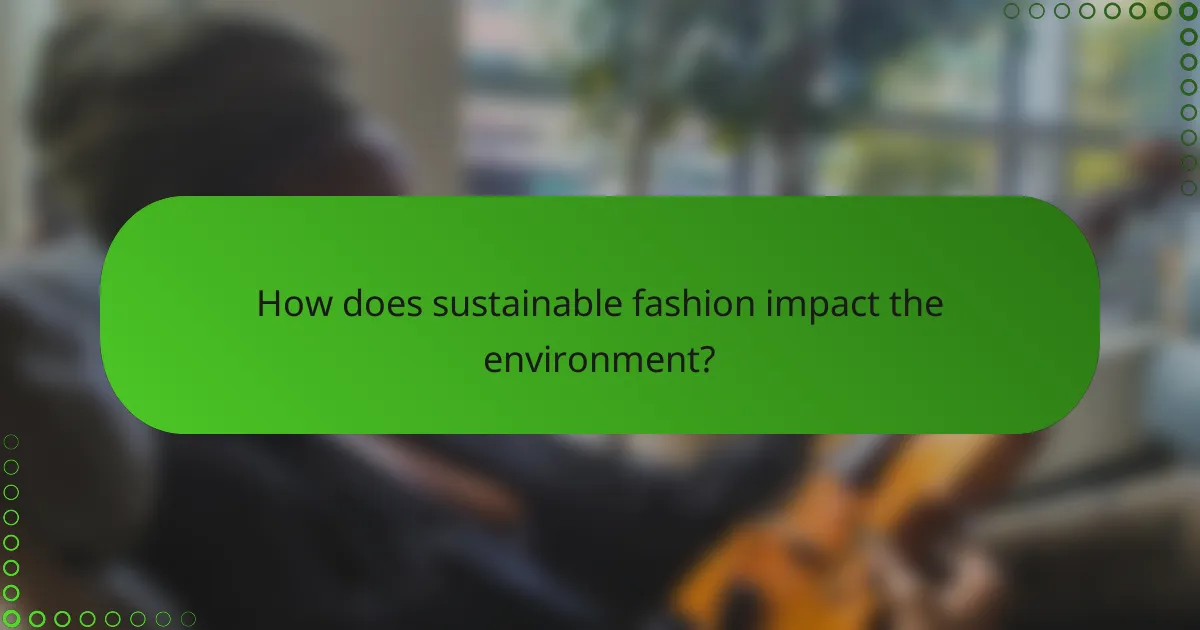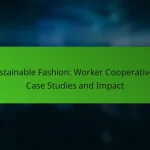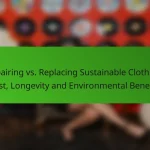Sustainable fashion emphasizes the importance of making conscious consumer choices that prioritize environmental and ethical considerations. By selecting eco-friendly brands, supporting local artisans, and exploring second-hand options, individuals can significantly reduce their fashion footprint. This shift not only benefits the planet but also promotes fair labor practices within the industry.

How can consumers make sustainable fashion choices?
Consumers can make sustainable fashion choices by being mindful of the brands they support, the materials they purchase, and the overall impact of their shopping habits. By prioritizing eco-friendly options, supporting local artisans, and considering second-hand purchases, individuals can contribute to a more sustainable fashion industry.
Choosing eco-friendly brands
Selecting eco-friendly brands is crucial for making sustainable fashion choices. Look for companies that prioritize ethical production practices, use sustainable materials, and are transparent about their supply chains. Brands that are certified by recognized standards, such as Global Organic Textile Standard (GOTS) or Fair Trade, often meet higher environmental and social criteria.
Researching a brand’s commitment to sustainability can involve checking their website for information on sourcing, manufacturing processes, and environmental initiatives. Avoid brands that engage in “greenwashing,” where they falsely claim to be environmentally friendly without substantial evidence.
Understanding sustainable materials
Familiarizing yourself with sustainable materials is essential for making informed fashion choices. Fabrics such as organic cotton, Tencel, and hemp have a lower environmental impact compared to conventional materials. These alternatives often require less water and fewer chemicals during production.
Additionally, recycled materials, like polyester made from plastic bottles, can help reduce waste. When shopping, check labels for information on material composition and certifications that indicate sustainable practices.
Supporting local artisans
Supporting local artisans fosters sustainable fashion by promoting craftsmanship and reducing carbon footprints associated with long-distance shipping. Local artisans often use traditional techniques and materials that are more environmentally friendly. By purchasing from them, you can help sustain local economies and preserve cultural heritage.
Look for local markets, craft fairs, or online platforms that feature handmade goods. This not only supports sustainable practices but also allows for unique, one-of-a-kind pieces that stand out from mass-produced items.
Prioritizing second-hand shopping
Prioritizing second-hand shopping is an effective way to make sustainable fashion choices. Buying pre-owned clothing extends the life cycle of garments and reduces the demand for new production, which can be resource-intensive. Thrift stores, consignment shops, and online resale platforms offer a wide variety of options at lower prices.
When shopping second-hand, consider the quality and condition of items to ensure they will last. This approach not only benefits the environment but can also lead to discovering unique fashion pieces that reflect personal style.

What are the benefits of sustainable fashion?
Sustainable fashion offers numerous advantages, including reduced environmental impact, support for ethical labor practices, and potential long-term cost savings for consumers. By choosing sustainable options, individuals can contribute to a healthier planet and promote fair working conditions in the fashion industry.
Environmental impact reduction
Sustainable fashion significantly reduces the environmental footprint of clothing production. This includes lower carbon emissions, reduced water usage, and less waste generated from discarded garments. For instance, organic cotton uses approximately 91% less water than conventional cotton, making it a more eco-friendly choice.
Additionally, sustainable brands often utilize recycled materials, which can minimize the need for new resources. By opting for clothing made from recycled fabrics, consumers can help decrease the demand for virgin materials and lessen pollution associated with textile manufacturing.
Support for ethical labor practices
Choosing sustainable fashion often means supporting brands that prioritize fair labor practices. Many sustainable companies ensure their workers receive fair wages, safe working conditions, and reasonable hours. This contrasts with fast fashion brands, where labor exploitation is more common.
By purchasing from ethical brands, consumers can promote a more equitable fashion industry. Look for certifications such as Fair Trade or GOTS (Global Organic Textile Standard) to identify companies committed to ethical labor practices.
Long-term cost savings
While sustainable fashion items may have a higher upfront cost, they often lead to long-term savings. High-quality, sustainably made garments tend to last longer than fast fashion items, which frequently wear out quickly. Investing in durable clothing can reduce the frequency of replacements, ultimately saving money.
Additionally, sustainable fashion encourages consumers to buy less but choose wisely. By focusing on versatile, timeless pieces, individuals can build a wardrobe that meets their needs without excessive spending. Consider creating a capsule wardrobe to maximize the utility of each item while minimizing costs.

Which brands lead in sustainable fashion?
Several brands are recognized for their leadership in sustainable fashion, focusing on eco-friendly practices and ethical production. Notable examples include Patagonia, Eileen Fisher, and Everlane, each adopting unique approaches to sustainability.
Patagonia’s commitment to sustainability
Patagonia is renowned for its strong commitment to environmental responsibility. The brand uses organic cotton, recycled materials, and promotes fair labor practices throughout its supply chain.
Additionally, Patagonia encourages customers to repair and recycle their products, offering a repair service and a take-back program. This approach not only reduces waste but also fosters a culture of sustainability among consumers.
Eileen Fisher’s circular model
Eileen Fisher has implemented a circular model that emphasizes the lifecycle of clothing. The brand focuses on creating timeless designs with sustainable materials, allowing garments to be worn longer.
Moreover, Eileen Fisher runs a take-back program where customers can return old items for recycling or resale. This initiative helps minimize textile waste and promotes a more sustainable fashion ecosystem.
Everlane’s transparent pricing
Everlane is known for its transparent pricing model, which breaks down the costs associated with each product. This approach allows consumers to understand the true cost of sustainable fashion, including materials, labor, and markup.
By providing detailed information about their factories and sourcing practices, Everlane builds trust with consumers and encourages informed purchasing decisions. This transparency is a key factor in promoting sustainable consumer choices.

How does sustainable fashion impact the environment?
Sustainable fashion significantly reduces environmental harm by promoting eco-friendly practices throughout the clothing lifecycle. This includes minimizing resource consumption, reducing waste, and lowering emissions associated with textile production and disposal.
Reduction of textile waste
Sustainable fashion emphasizes the importance of reducing textile waste, which is a major environmental issue. Approximately 92 million tons of textile waste are generated globally each year, much of which ends up in landfills. By choosing sustainable materials and promoting recycling and upcycling, consumers can help mitigate this problem.
Brands that focus on sustainable practices often implement take-back programs, allowing customers to return old garments for recycling. This not only helps reduce waste but also encourages a circular economy where materials are reused rather than discarded.
Lower carbon footprint
The carbon footprint of the fashion industry is substantial, accounting for a significant portion of global greenhouse gas emissions. Sustainable fashion aims to lower this footprint by using renewable resources, reducing energy consumption, and opting for local production methods. For instance, organic cotton farming typically uses less energy compared to conventional methods.
Consumers can contribute to lowering the carbon footprint by choosing brands that prioritize sustainability and transparency in their supply chains. Additionally, buying second-hand clothing or investing in high-quality, durable pieces can further decrease overall emissions associated with fast fashion practices.

What educational resources are available for sustainable fashion?
Various educational resources are available for those interested in sustainable fashion, including online courses, documentaries, and books. These resources help consumers understand ethical practices, the impact of the fashion industry, and how to make informed choices.
Online courses on sustainable practices
Online courses offer flexible learning options for individuals looking to deepen their understanding of sustainable fashion. Platforms like Coursera and edX provide courses from reputable institutions that cover topics such as eco-friendly materials, sustainable production methods, and the circular economy.
When selecting a course, consider the duration, level of expertise required, and the specific focus areas that interest you. Many courses are free or available for a nominal fee, making them accessible to a wide audience.
Documentaries highlighting the fashion industry
Documentaries serve as powerful tools for raising awareness about the environmental and social issues within the fashion industry. Films like “The True Cost” and “RiverBlue” expose the hidden costs of fast fashion and the impact on communities and ecosystems.
Watching these documentaries can inspire viewers to rethink their purchasing habits and advocate for more sustainable practices. They often include interviews with industry experts and activists, providing a well-rounded perspective on the challenges and solutions in fashion.
Books on ethical fashion
Books on ethical fashion provide in-depth insights into sustainable practices and the philosophy behind them. Titles such as “Dress Eco” and “Fashionopolis” explore the industry’s impact and offer practical advice for consumers seeking to make responsible choices.
Reading these books can enhance your understanding of sustainable fashion’s complexities, including the importance of transparency and the role of consumer demand. Look for books that include case studies or actionable tips to implement in your own wardrobe.

How can awareness be raised about sustainable fashion?
Raising awareness about sustainable fashion involves educating consumers on the environmental and social impacts of their clothing choices. Effective strategies include leveraging social media and organizing community workshops to engage and inform the public.
Social media campaigns
Social media campaigns can effectively spread information about sustainable fashion by utilizing platforms like Instagram, Facebook, and TikTok. These campaigns often feature influencers who promote eco-friendly brands, share tips on sustainable practices, and highlight the importance of ethical consumption.
To maximize impact, campaigns should use visually appealing content, such as infographics and videos, that clearly convey messages about sustainability. Engaging hashtags can also help increase visibility and encourage user participation.
Community workshops
Community workshops provide hands-on opportunities for individuals to learn about sustainable fashion practices. These events can cover topics such as upcycling, responsible shopping, and the benefits of choosing sustainable materials.
Workshops can be organized in collaboration with local businesses or environmental organizations, making them accessible and relevant to the community. Providing resources, such as DIY kits or informational brochures, can enhance the learning experience and encourage ongoing sustainable practices.









